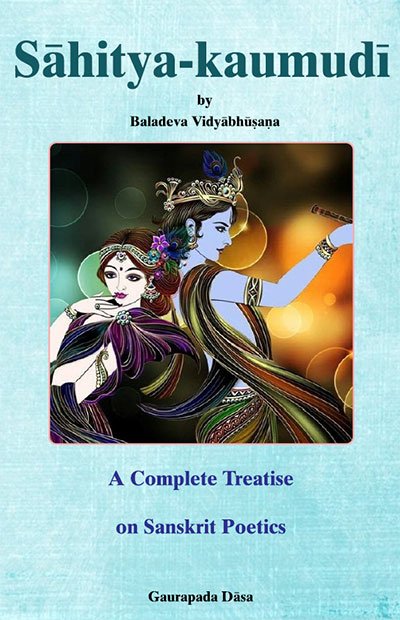Sahitya-kaumudi by Baladeva Vidyabhushana
by Gaurapada Dāsa | 2015 | 234,703 words
Baladeva Vidyabhusana’s Sahitya-kaumudi covers all aspects of poetical theory except the topic of dramaturgy. All the definitions of poetical concepts are taken from Mammata’s Kavya-prakasha, the most authoritative work on Sanskrit poetical rhetoric. Baladeva Vidyabhushana added the eleventh chapter, where he expounds additional ornaments from Visv...
Text 9.50
उदाहरणम्,
तव तनु-शरीर-सदृशीं काञ्चन कनकस्य वीरुधं नेक्षे ।
राधे सुमुखि भवत्या मुख-वद् अनङ्को’पि शुभ्रांशुः ॥
udāharaṇam,
tava tanu-śarīra-sadṛśīṃ kāñcana kanakasya vīrudhaṃ nekṣe |
rādhe sumukhi bhavatyā mukha-vad anaṅko’pi śubhrāṃśuḥ ||
tava—to Your; tanu—thin; śarīra—body; sadṛśīm—similar; kāñcana—any [creeper]; kanakasya—of gold; vīrudham—creeper; na īkṣe—I do not see; rādhe—O Rādhā; su-mukhi—O girl with a beautiful face; bhavatyāḥ—of Yours; mukha-vat—like the face; anaṅkaḥ—spotless (immaculate); api—even; śubhra-aṃśuḥ—a moon (“whose rays are beautiful”).[1]
O Rādhā, I do not see any golden creeper that resembles Your thin body. O girl with a beautiful face, even a spotless moon would not compare to Your face. (Alaṅkāra-kaustubha 7.104)
atraikasya śabdasya parivṛttau nāyam alaṅkāras tena śabdāśrayaḥ. parasya parivṛttau tu sa na hīyate tenārthāśrayaś cety ubhayālaṅkāratā tathāpy asya śabdālaṅkārāntaḥ-pātaś cirantanānusārāt.
In this verse, the ornament would not occur if one of the two sounds were replaced, consequently there is a foundation of sound. However, the ornament would not be impaired if the other sound were replaced, consequently there is a foundation of meaning. Thus here punar-uktavad-ābhāsa is an ornament of sound and of meaning (ubhaya alaṅkāra). Nonetheless, in accordance with the ancients, it falls in the category of ornaments of sound.
Commentary:
The punar-uktavad-ābhāsa in the verse occurs three times: (1) tanu and śarīra (body); here tanu means “thin”, (2) kāñcana and kanaka (gold); here kāñcana means kāṃcana (some), and (3) mukha and vadana (mouth), where vadana is only part of the sound “mukha-vad anaṅko.”
In the first one, the punar-uktavad-ābhāsa would be lost if tanu were replaced with a synonym of the meaning in which it is used here (thin), but it would not be lost if śarīra were replaced with a synonym, such as deha (body), because here śarīra is used as a synonym of tanu in the sense of “body”. The same applies to the second one and to the third one.
Further, the poetical rhetorician Pīyūṣa-varṣa Jayadeva shows this verse as an example of a seeming redundancy where the sounds that make the punar-uktavad-ābhāsa are not juxtaposed.
In the first half of the verse he defines the ornament:
punarukta-pratīkāśaṃ punaruktārtha-sannibham |
aṃśu-kāntaṃ śaśī kurvann ambarāntam upaity asau ||punaḥ-ukta—of a repetition (“what is said again”); pratīkāśam—a resemblance; punaḥ-ukta-artha—a meaning that is said again; sannibham—like; aṃśu—by means of rays; kāntam—beauty; śaśī—the moon; kurvan—while making; ambara—of the sky (or of the garment); antam—the middle; upaiti—goes; asau—it.
“A seeming redundancy is what seems like a redundant meaning: “While making beauty with its rays, the moon reaches the middle of the sky”” (Candrāloka 5.7).
In aṃśu-kāntam and ambarāntam, the meaning of the word antam (inside, i.e. middle) seems to be used twice. This instance of punar-uktavad-ābhāsa is founded on a part of a word: antam seems to be repeated, as if aṃśu-kāntam (beauty with the rays) meant aṃśuka-antam (the inside of the blouse): “The moon reaches the inside of the garment (ambara-antam) while making the inside of the blouse.” This constitutes a semblance of paronomasia (śleṣābhāsa) (Commentary 10.133); Rudraṭa calls it asambhava-śleṣa (an impossible double meaning) (Kāvyālaṅkāra 10.16).
In Kāvya-prakāśa, the chapter ends here. In the text below, Baladeva Vidyābhūṣaṇa discusses an offshoot of the topic of ubhaya alaṅkāra (ornament of sound and of meaning). It actually belongs to the topic of the types of attributes in common in a simile and so on (10.2; 10.20).
Footnotes and references:
[1]:
According to Viśvanātha Cakravartī, the words na bhavati (is not) need to be supplied to the last sentence: he rādhe, bhavatyā mukha-vad anaṅko niṣkalaṅko’pi śubhrāṃśuś candro na bhavatīty arthaḥ (Subodhinī 7.104).
